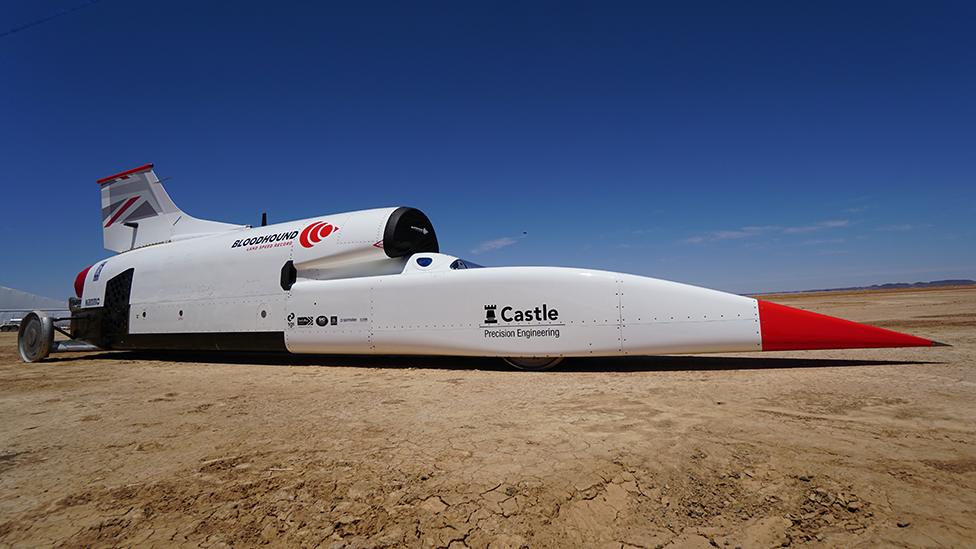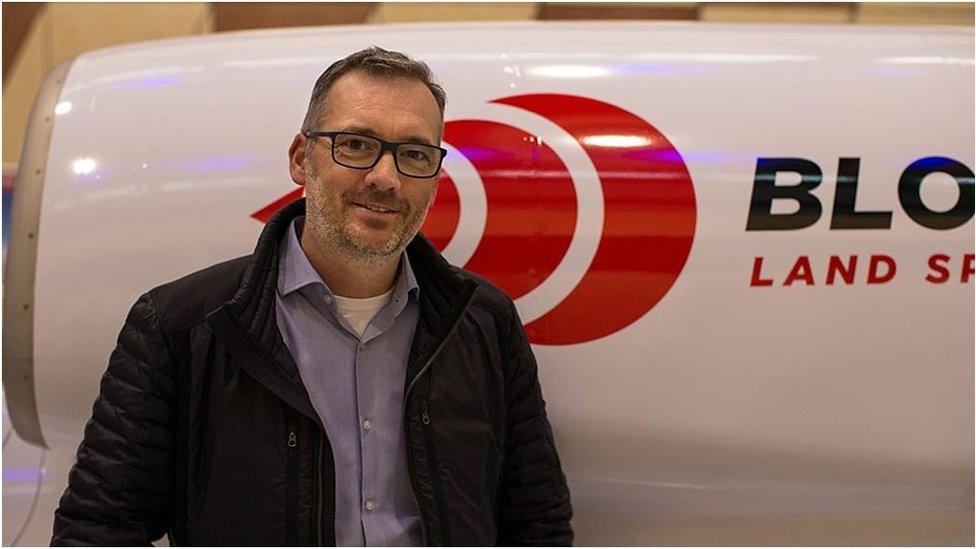Bloodhound supersonic car project up for sale
- Published

The Bloodhound supersonic car that was built to break the land speed record is up for sale.
Current owner Ian Warhurst says he's de-risked the project by running the vehicle above 600mph, but it's now time for someone else to take on the effort.
Bloodhound became one of the fastest cars in history during trials in the Kalahari desert in 2019.
But it needs the addition of a rocket motor to break the all-time record speed of 763mph (1,228km/h).
Yorkshireman Warhurst has calculated the cost of achieving this to be £8m.
"I've gone as far as I can with it," he told BBC News. "I can't put any more of my own money into the project, so it's time for me to pass the baton to someone else to complete the job. And I'll be cheering from the sidelines."
Trailer from the BBC film - Bloodhound: Chasing the Land Speed Record
The arrow-shaped racer reached a top speed of 628mph (1,010km/h) on the lakebed of Hakskeen Pan, South Africa, in late 2019. Only seven cars had previously ever gone faster than 600mph.
All the data acquired over several weeks of running indicated that Bloodhound was well capable of achieving 800mph if it was fitted with a rocket to supplement the power coming from its Eurofighter-Typhoon jet engine.
And while sponsorship interest had been high turning into 2020 to begin thinking about this development, Mr Warhurst was then forced to mothball the project when the Covid pandemic struck.

Ian Warhurst paid for the 2019 trials out of his own pocket
A purchaser would take control of Grafton LSR Ltd, the holding company that owns the Bloodhound LSR project.
Whatever happens in the coming weeks, the car itself will never be broken up, which was a real threat before Mr Warhurst rescued the project from administration in 2018.
"I won't let that happen. At the very least, Bloodhound will go into a museum for everyone to admire and be inspired by. But, really, the record is there for the taking," he said.
Watch Bloodhound race past a camera buried in the lakebed track (Video by WorkerBee)
And retirement to a museum is certainly not Plan A for driver Andy Green, who set the current world land speed record in the Thrust SSC car back in 1997.
"There is still a fantastic opportunity here. We've proved Bloodhound has record-breaking potential. We just need another Ian-like character to come in and say, 'I get what Bloodhound's about, I can see it's showcasing Great British engineering and technology'. This project works for education, and it's a good news story.
"You can probably guess from my tone of voice, I'm still feeling very bullish about this. Bloodhound is not dead yet."

To achieve 800mph, the car needs five to six tonnes of thrust on top of the nine tonnes it already receives from the Eurofighter jet engine.
The extra power will come from a booster supplied by the Norwegian aerospace company Nammo.
Bloodhound's engineers still need to develop the pump system that feeds this rocket with a high-test peroxide monopropellant. And they have in mind to introduce an electric element - a battery or supercapacitor to run the motor that drives the pump.
This would make Bloodhound, on one level, a hybrid vehicle.
It's the obvious solution, says Mr Warhurst: "This is where motorsport is going, and we were talking to various manufacturers about them coming onboard to showcase their technology."
The rocket and electric upgrades would take some time to implement. To make a land speed record attempt a viable prospect in 2022, the new owner therefore really needs to be in control, bringing the engineering team back together, by Easter at the latest.
The Bloodhound project is currently based at SGS Berkeley Green University Technical College (UTC) in Gloucestershire.
